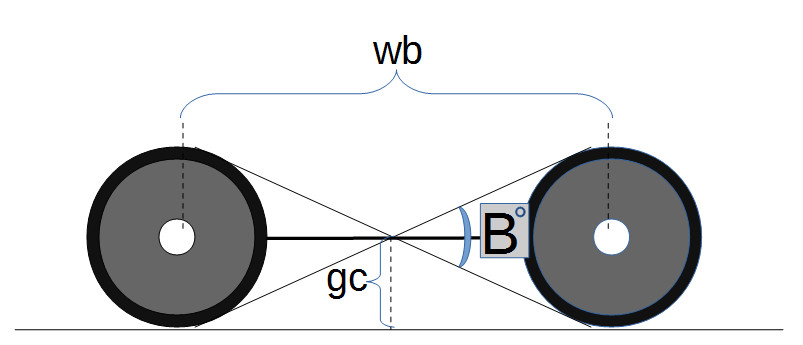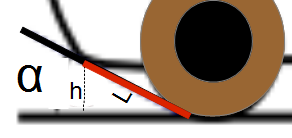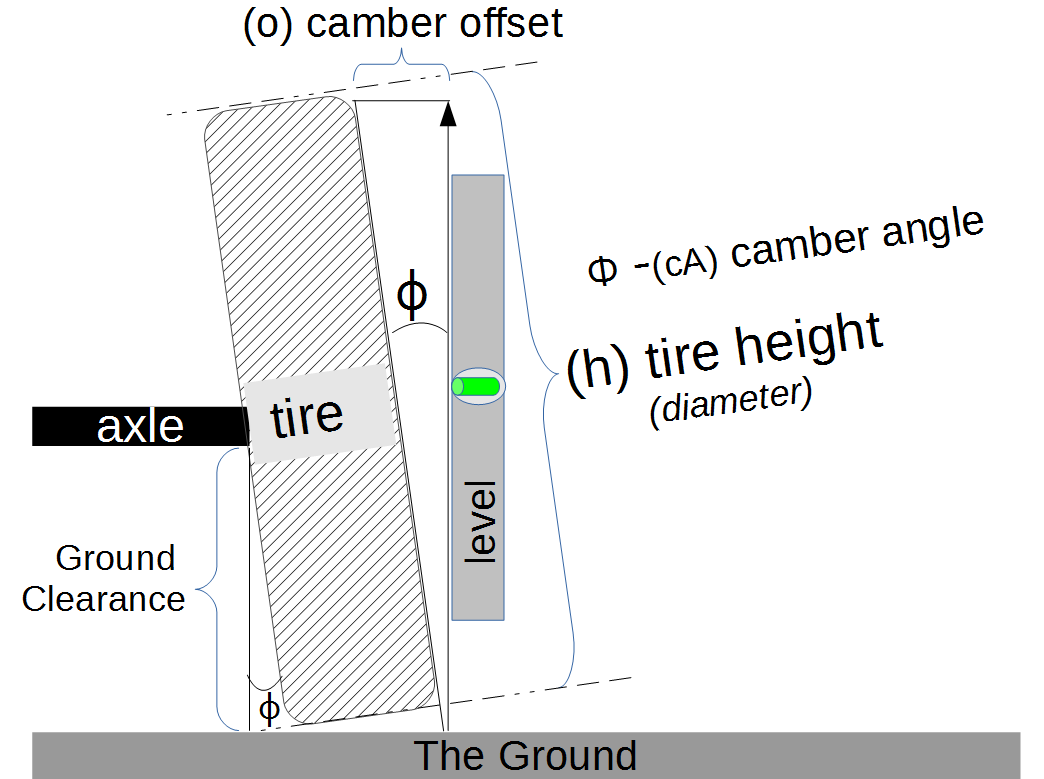The Breakover Angle calculator computes the maximum angle that a vehicle can drive over without the ground touching the vehicle's undercarriage.
 Breakover Angle(B), Wheel Base (wb)
Breakover Angle(B), Wheel Base (wb)
and Ground Clearance (gc)
INSTRUCTIONS: Choose units and enter the following:
- (gc) Ground Clearance. This is measured between the flat ground and the lowest point in the vehicle's undercarriage, and
- (wb) Wheel Base. This is measured between the centers of the two wheels (axles).
Breakover Angle (B°): The calculator returns the Breakover Angle in degrees. However this can be automatically converted to compatible units via the pull-down menu.
The Math / Science
The formula for breakover angle is:
B° = 2 * tan-1 ( (2 * gc)/ wb)
where:
- B° = breakover angle
- gc = Ground Clearance
- wb = Wheel Base
Note: The default units are in inches(in). However other units (e.g. centimeters) can be selected via the pull-down menu on the right of the input fields.
α° = Approach angle: ß° = Departure angle

Camber Angle (Φ) 
Definition
'''Breakover angle''' is the maximum possible supplementary angle (usually expressed in degrees) that a vehicle, with at least one forward wheel and one rear wheel, can drive over without the apex of that angle touching any point of the vehicle other than the wheels. Curbstone Clearance, Approach, Departure, and Ramp Breakover Angles.
Passenger Car and Light Truck: This definition is contingent upon the wheels being in continuous contact with the supporting surface(s). Breakover angle may also be referred to as "break-over angle" or "break over angle." Breakover angle is different from ground clearance in that ground clearance is the shortest distance between the ground and lowest point on the vehicle.
Relevance
Breakover angle is a relevant performance metric in many common vehicle scenarios, including: Breakover diagram from Wikipedia
Breakover diagram from Wikipedia
- Off-roading.
- Loading a vehicle onto a higher surface with a ramp.
- Going over raised railroad crossings.
If a vehicle drives over a breakover angle larger that computed, the undercarriage of the vehicle will make contact with the ground. This can damage the undercarriage, impede the vehicle from movement or take weight off of the steering and/or traction wheels.

Vehicle Calculators
- Approach (Departure) Angle: Computes the maximum angle of a ramp onto which a vehicle can climb without scraping.
- Degree to Percent Grade: Converts a grade to a degree angle.
- Camber angle - Wheel camber (tilt) calculation of angle
- Camber offset - Wheel camber (tilt) calculation of offset
- Breakover Angle: Compute maximum angle that a vehicle can drive over without the ground touching the vehicle's undercarriage.
- Time to Overtake: Computes the time for one object to overtake another.
- Distance to Overtake: Computes distance traveled to overtake another.
- Speed to Overtake: Computes the average velocity to overtake another.
- Distance at Speed: Computes the distance traveled over a period of time at a constant velocity (speed).
- Speed from Skid Marks: Estimates the speed of a vehicle based on length of skid marks.
- Braking Distance: Estimates distance to stop a vehicle based on initial velocity and braking coefficient.
- Total Stopping Distance: Computes the distance to stop a vehicle based on the initial velocity, reaction time and a braking coefficient.
- Speed from the Braking Distance: Estimates the initial speed based on the distance to stop a vehicle and the a braking coefficient.
- Used Car Price Comparison: Estimates the better value between two vehicles based on their mileage, cost and expected lifespan (miles).
- Belt Length: Computes the length of a belt that goes around two pulleys based on the pulley diameters and the distance between the axles.
- Belt Speed: Computes the speed at which a linear length of belt travels around a pulley based on the diameter of the pulley and the rotation rate.
- Pulley RPMs: Computes the RPMs of a pulley based on the belt speed and diameter of the pulley.
- 2nd Pulley RPMs: Computes the RPMs of a second pulley based on the the RPMs and Diameter of the first pulley and the diameter of the second pulley.
- 2nd Pulley Diameter: Computes the diameter of a second pulley based on the RPMs and diameter of the first pulley and the RPMs of the second pulley.
- RPM of 4th pulley on three shafts: Computes the RPMs (rotation rate) of a pulley when the RPM and Diameters are known for a series of pulleys on three axles.
- 2nd Gear RPM: Calculates the RPMs of a second gear when the RPMs and number of teeth are known for the first gear and the number of teeth of the second gear is known,
- 2nd Gear Torque: Calculates the torque of a second gear when the torque and number of teeth are known for the first gear and the number of teeth of the second gear is known,
References
- Wikipedia - http://en.wikipedia.org/wiki/Breakover_angle
External links
*HowStuffWorks: [http://adventure.howstuffworks.com/outdoor-activities/off-roading/off-roading1.htm The Physics of Off-Roading].